Piezoelectric and Dielectric Properties of PZT-Epoxy Composite Thick Films-Juniper Publishers
JUNIPER
PUBLISHERS- ACADEMIC JOURNAL OF POLYMER SCIENCE
Abstract
Composite piezoelectric thick films are envisioned
for energy harvesting, energy storage, and advanced sensor applications.
This work focuses on PZT-epoxy-aluminum thick films that were
fabricated using a two-step spin coat deposition and annealing method.
The volume fraction of the PZT filler ranged from 0.2 to 0.4, and the
aluminum volume fraction was varied from 0.10 to 0.17 for each PZT
volume fraction, respectively to ascertain the percolation range of the
devices and the influence of the aluminum on the device piezoelectric
and dielectric properties. An aluminum filler was included in the
PZT-epoxy composite to enhance the polarization process of the composite
and to enhance the dielectric properties of the composite. The
piezoelectric strain coefficients d33 and d31, and
capacitance were measured and studied as a function of aluminum volume
fraction and top electrode material (silver and gold). It was determined
that beyond a critical volume fraction of aluminum, the aluminum
particles formed conductive pathways within the composite (percolation
threshold region) which diminished piezoelectric strain coefficients
beyond the percolation threshold value. The percolation thresholds for
these samples were found to occur from 0.13 and 0.17 volume fraction of
aluminum, which agrees with theoretical predictions. SEM micrographs
were used study the interactions between various phases of the
composite.
Keywords: Aluminum; Thick films; Silver; Biomedical
Abbrevations:
MOD: Metal Organic Decomposition; MOCVD: Metal Organic Chemical Vapor
Deposition; PLD: Pulsed Laser Deposition; SEM: Scanning Electron
Microscopy
Introduction
Ferroelectric films have been of interest over the
last 20 years because of the possibility of using them for non-volatile
memory applications [1-3], MEMS [4-6], ultrasonic devices [4,7], battery
separators [8-10], biomedical scaffolds [11] and energy harvesting
devices where they are coupled with batteries [12]. The properties if
piezoelectric films cannot be compared directly with those of bulk
materials of the same composition because their processing and
electrical properties differ. Previous work on the preparation of
piezoelectric films includes RF planar magnetron sputtering [13,14], ion
beam sputtering [15] or DC magnetron sputtering [16], where most
recently, researchers have succeeded in fabricating films using various
chemical methods of deposition such as; metal organic chemical vapor
deposition (MOCVD) [17- 19], chemical solution deposition [20,21],
metal-organic decomposition (MOD) [22,23], and also pulsed laser
deposition (PLD) [24-26]. The sol-gel method has the benefits of
compositional control, reduced temperature processing of highly uniform,
dense, crack-free films and low cost of fabrication [27,28]. These
methods of processing ferroelectric films have
been used with notable success to produce piezoelectric ceramic films
comprised of Lead Zirconate Titanate (PbZrxTi1-xO3 also known as, PZT).
PZT has a high dielectric constant, ferroelectric, piezoelectric, and
pyroelectric properties. The ideal properties of PZT have made its
application to transducer, sensor and actuator devices ubiquitous.
However, the poor mechanical strength of these devices has limited their
life cycle and performance. Therefore, interest in polymer-ceramic
[29-33] (and ceramic-ceramic [34,35]) composites has emerged as an area
of interest because polymers are flexible, low cost, easily processed
[36,37] and able to be polarized under the influence of an external
electric field [38].
Piezoelectric ceramic/polymer composites possessing
various connectivity patterns have been the focus of much study over the
past several years [34, 35, 39-42]. Among the composites examined, the
simplest types are those with 0-3 connectivity [39,43]. Piezoelectric
composites with 0-3 connectivity consist of piezoelectric ceramic
particles dispersed in a three dimensionally connected matrix [1, 5,
29-32, 34, 35, 44-48]. The advantages of these composites lie in the
ease in which they may be processed
into fairly complex shapes, including but not limited to thin sheets,
molded shapes and extruded bars and fibers [39]. The most documented
of piezoceramics used in composites such as these is PZT
[4, 20, 42, 49-52].
Banerjee et al., [34] studied the influence of aluminum
inclusions on the dielectric properties of three-phase PZT cement
aluminum composites, where the aluminum and PZT particles
were dispersed in a Portland cement matrix. The fabricated
samples were nominally 6mm in thickness and were poled at a
low poling voltage of 0-6kV/mm at a temperature of 160 ͦC in air.
It was reported that three-phase composites possessed a higher
piezoelectric strain coefficient (d33) than two-phase composites.
The highest value of d33 observed for the three-phase composite
was 8.1 pC/N for volume fractions equal to 0.7 and 0.2 for PZT and
Al, respectively. This d33 value for the three-phase piezoelectric
composite was 1.64 times the value measured for the two-phase
composite. Banerjee et al., [53] also investigated the influence
of micro and nano sized aluminum inclusions in a three-phase
PZT-Epoxy-Al bulk composite. The fabricated composites were
~ 6mm thick and were comprised of micron sized aluminum
powder and PZT. These devices had higher dielectric constants
that the composites that incorporated nanosized aluminum
particles (both sets of samples were polarized at the same value:
0.2 kV/mm in air) due to interfacial effects, contact resistance and
increased agglomeration. Specifically, for composites with PZT
volume fractions equal to 0.20, 0.30 and 0.40 and micron- sized
aluminum particles, the dielectric constants were equal to 405.7,
661.4, and 727.8 (pC/N), respectively. On the other hand, the
dielectric constants for composites that were comprised of nano
sized aluminum particles the (the same PZT volume fractions)
dielectric constants were equal to 233.28, 568.81, and 657.41
(pC/N), respectively. They concluded that samples that contained
micron sized aluminum inclusion yielded higher dielectric
constant values compared to the Nano sized aluminum inclusions,
which resulted in higher dielectric values for samples with micron
sized piezoelectric fillers.
In this work, PZT-aluminum-epoxy thick film composites
were fabricated where the volume fractions of PZT and Al were
varied from 0.20 to 0.40 (increments of 0.10) and 0.0 to 0.17,
respectively. A minimum of three samples were fabricated for each
of the studies. In addition, two different types of top electrodes
(sputtered gold and silver paint) were prepared and compared in
terms of piezoelectric and dielectric constants. The change in the
piezoelectric and dielectric properties with respect to time was
also observed over a five-day period.
Materials and Methodology
The materials used in all experiments were PZT powder
(READE), DGEBA Epofix TM Cold-Setting embedding resin
(Electron Microscopy Sciences) [54], and aluminum -99.97%, 200
mesh i.e. ~ 75μm (Acros Organics) and 0.0254mm stainless steel
substrates (Alfa Aesar). The piezoelectric and physical properties
of the materials are presented in Table 1 & 2, respectively. The
properties for the aluminum were obtained from the manufacturer
website [55,56].
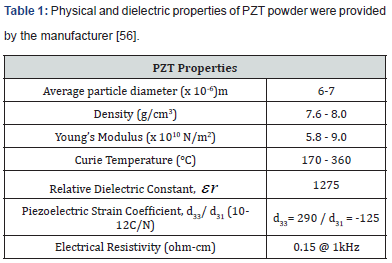

*Experimental values
PZT epoxy aluminum thick composite films were deposited
onto stainless steel substrate using a spin coat and deposition
technique. The stainless-steel squares were 25mm x 25mm and
0.0254mm thick. An overview of the fabrication process for the
devices is provided in Figure 1. The volume fractions of the PZT
and aluminum were varied from 0.20 to 0.40 and 0.01 to 0.17,
respectively. As shown in Figure 1, the PZT, aluminum and epoxy
were weighed to achieve the desired volume fraction and then combined in a beaker. The contents in the beaker were hand
stirred for 5minutes and 5ml of ethanol was added to this mixture.
The mixture was subsequently sonicated in an ultra sonicator
for 1hour, while being hand stirred every 15minutes. The epoxy
hardener was then added to the mixture. The final compound
was then poured onto the stainless-steel substrate using a
dropper while the spin coater was rotated from 100 - 500rpm
for 30seconds, and subsequently by 1000rpm for 60seconds. The
initial low rpm enabled an even distribution of the compound
over the substrate.
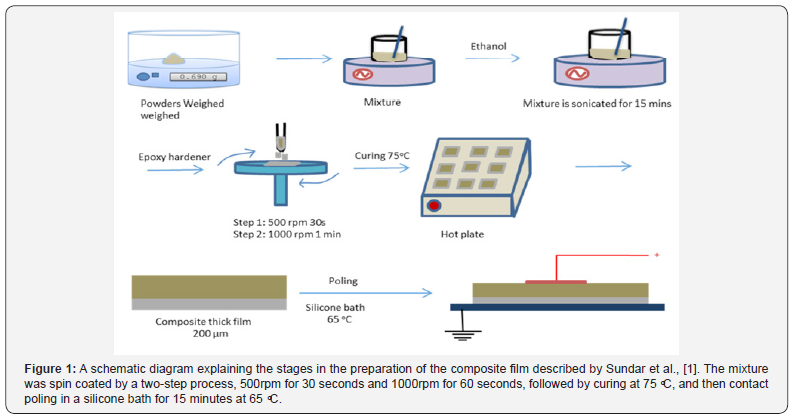
After the spin coating process, the samples were removed and
cured on a hot plate in the presence of air for 8 hours at 75 ͦC.
The samples were then cooled for 24 hours and eventually coated
with colloidal silver paint as the top electrode. Samples were then
contact poled at a voltage of 2.2kV/mm at 65 ͦC in a silicone oil
bath for 15 minutes. An additional set of samples were prepared,
where the volume fractions of PZT and aluminum were 0.3 and
0.05, respectively. Sputtered gold was used as the top electrode for
these samples instead of colloidal silver paint. All samples were
then wrapped in aluminum foil and stored at room temperature
in the air for
24 hours to remove any remaining residual charges that may
be on the samples.
Dielectric and piezoelectric characterization
The piezoelectric strain coefficients, d33 and d31, and capacitance,
were measured using a Piezo Meter System manufactured
by Piezo Test, Piezoelectric Materials & Device Testing Company,
while the resistance was obtained using an Impedance/Gain
Phase Analyzer (HP4194A). All the measurements were taken after
polarization of the sample. The dielectric constant was calculated
using the expression,

In Equation (1), is the capacitance in Farads, A is the area of
the sample, is the permittivity of free space ≈ 8.854×10e-12Fm–1;
and t is the thickness of the sample. The impedance analyzer was
used to measure the real part of the resistance, R, of each sample,
and the resistivity was determined from Equation (2),

Material morphology and surface characterization
The surface morphology of the individual phases and the
composite was examined using scanning electron microscopy
(SEM) micrographs. Two types of images were gathered for these
composites, one was from the top surface of the sample, which
provides information about the distribution of the individual
phases within the polymer matrix, and the other was the crosssectional
image along the thickness of the sample. The crosssectional
image represents how the particles are distributed along
the thickness and a macroscopic view of the composite substrate
interface.
Results and Discussion
Surface morphology
The surface morphology of the composite films and the
particle distribution within the composite were observed via
scanning electron microscopy (SEM) and energy dispersive X-ray
spectroscopy (EDS) micrographs. PZT epoxy-aluminum samples
that were comprised of 0.30 PZT and 0.09 aluminum (by volume
fraction) were observed.
The cross-sections of the samples were obtained by cutting
the sample using a blade and placing the samples onto the SEM stud to reveal the samples cross-sectioned thickness or surface
morphology.
In Figure 2, a SEM micrograph of the cross-section of the film
is presented at 467× magnification. There do not appear to be any
microscopic pores or delamination points at the interface between
the substrate and the film. In Figure 3, the surface morphology of
the composite film is depicted at a magnification of 520 X. PZT
and aluminum particle agglomeration are observed in this SEM
micrograph. The agglomeration may be attributed to several
mechanisms of agglomeration, e.g. Brownian, gravitational,
turbulent, and electrostatic, where the gravitational form could
be mitigated n theory by the spin coating process. The as received
PZT and aluminum powders tend to naturally form clusters that
vary between 5-20μm in the case of aluminum and 10-25μm
in the case of PZT as shown in Figure 4A and Figure 4B, where
these agglomerations are most likely attributed to electrostatic
agglomeration. Though ethanol was used to change the surface
charge of the powder particles, its addition did not effectively
change the pH of the solution to negate the surface charge on
the all of the particles, which diminished its effectiveness in
counteracting the electrostatic forces between particles. The
extent of the effective- ness of the ethanol on the pH of the solution
was also a function of the number of particles within the colloidal
sol gel.
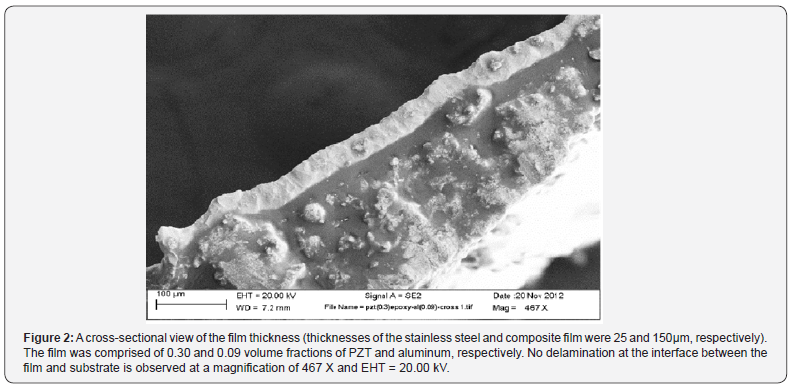
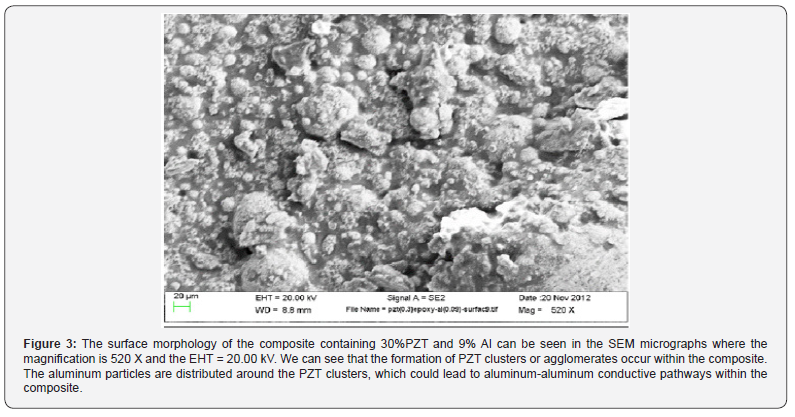
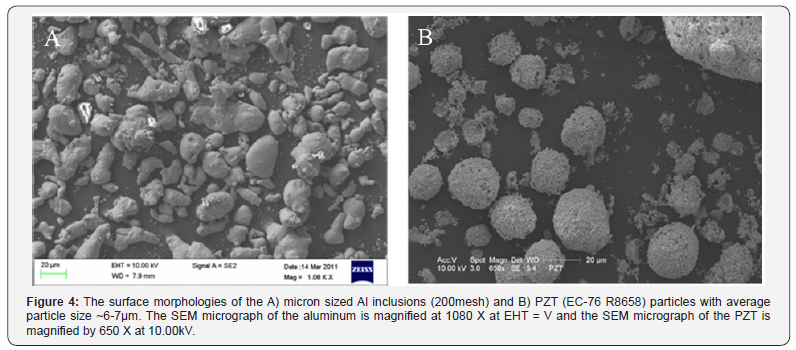
Piezoelectric and dielectric characterization
In Figure 5 & 6, the piezoelectric strain coefficients, d31 and
d33, for PZT-epoxy film composites are plotted as a function of PZT
volume fraction. The films were fabricated in a similar manner
as the 0-3-0 films, only they were Corona polarized at 15 kV/cm,
instead of Contact Parallel Plated polarized. In Figure 7 & 8, the
piezoelectric strain coefficients, d31 and d33 of the composites are
plotted as a function of Al (0.0 to 0.17) for volume fractions 0.2, 0.3
and 0.4 of PZT, respectively. The PZT-epoxy samples were Corona
polarized, but the three phase, 0-3-0 composites were parallelplate
contact polarized. As expected, the piezoelectric strain
coefficients, d31 increased with PZT content and aluminum content
up to 0.13, beyond which there is a steep decline in d31 values. The
increase in d31 values is consistent with many re- searchers such
as [42,49,57], who demonstrated increased values of d31 with
increased PZT content within a piezoelectric polymer composite. A
similar trend is expected for d33 values of the composite. However,
the magnitude of the d31 values is considerably higher than the d33
values owing to the higher strain in the direction along the 1-axis
as compared to the strain in the 3-axis. The range of the values of
d31 and d31 are consistent with [49,58] where the active particle
size was <34m with a poling voltage equal to 10kV/mm at room
temperature, which is consistent with the data presented here.
The differences in the d31 and d31 values for the 0-3 and the 0-3-0
composites are greater for lower volume fractions of PZT, but the
advantage of Corona poling over Contact Parallel plate is evident
at lower volume fractions of aluminum.
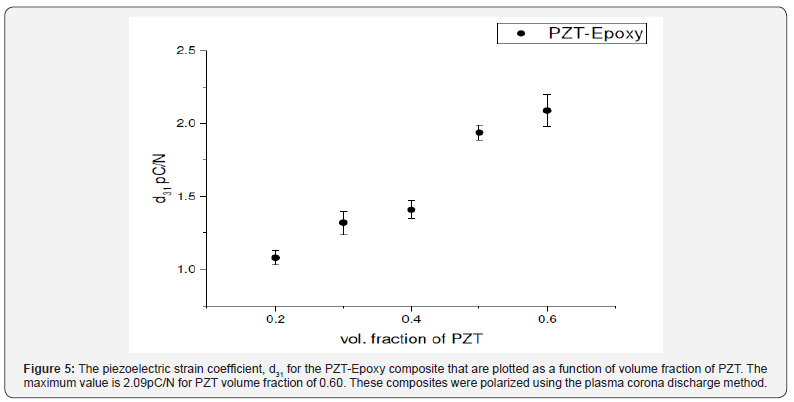
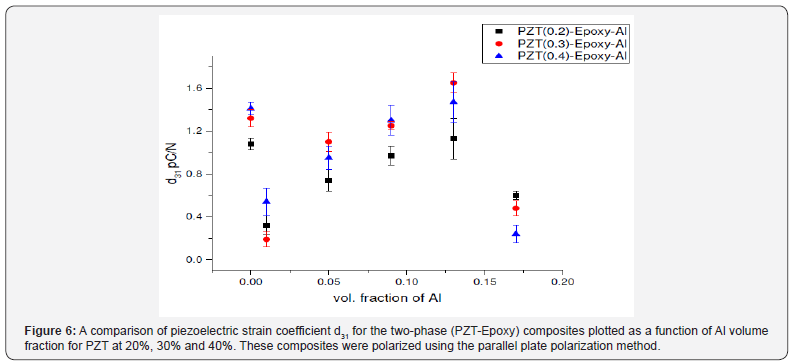
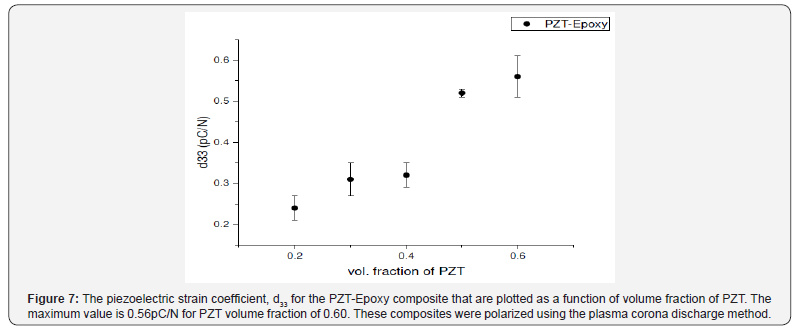
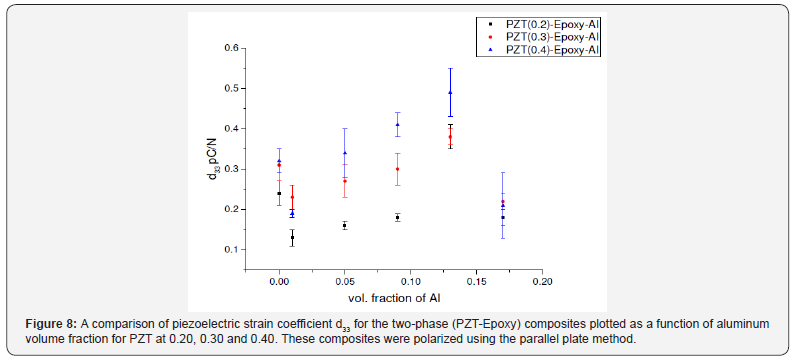
However, at a higher volume fraction of the aluminum (0.13),
the d31 values slightly surpassed those of the PZT-epoxy values
for PZT volume fractions of 0.3 and 0.4.
The capacitance and dielectric constants of the two-phase
composites are presented in Figure 9 & 10. The capacitance
and dielectric constants were found to increase with PZT
content, where the maximum value was ~8 pF and ~412 for the
capacitance and permittivity, respectively for a volume fraction of
0.60 for PZT. It was observed that as the PZT con- tent increased,
the polarization of the composite enhanced due to PZT’s inherent
ferroelectric property. Hence, higher overall dielectric constants
were observed. It is expected that as the polarization density
increases, the ability to store charge in the materials is enhanced
as a function of the polarization vector magnitude. The dielectric
constants for the three-phase samples are presented (Figure 12).
The dielectric constants for all samples increase with volume
fraction of PZT and aluminum as was similar to the observations
of [59-61]. All samples containing the aluminum filler had higher
dielectric constants than their two-phase counterparts. The
three-phase system with aluminum particles closely resembled a
percolative system [62-68].
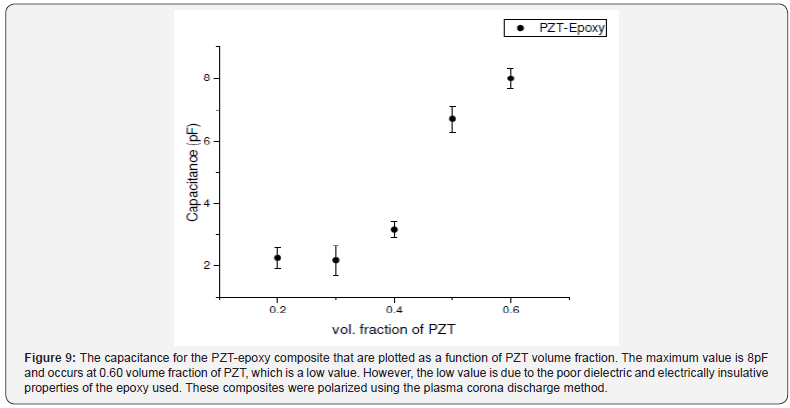
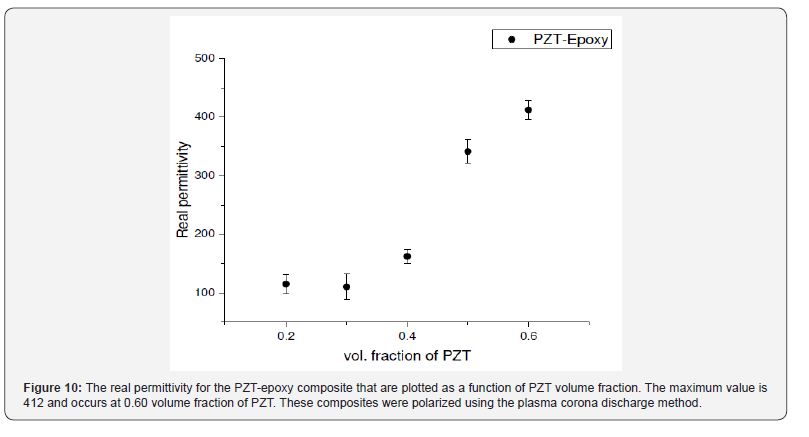
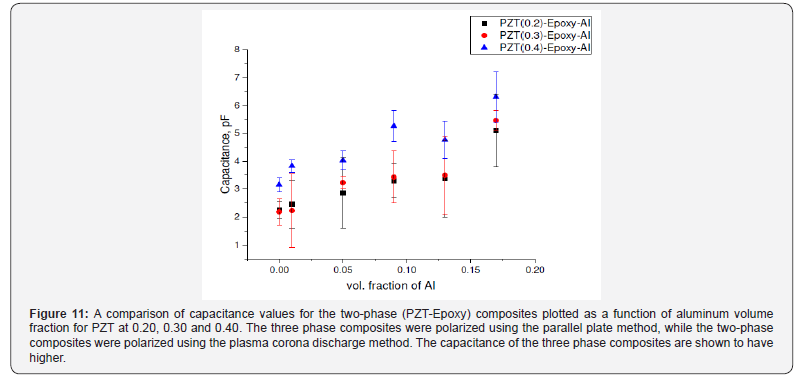
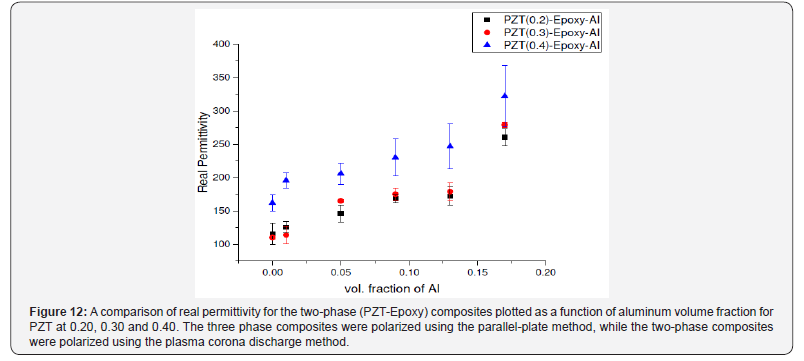
This interfacial polarization or the so-called Maxwell-Wagner
effect is responsible for the enhancement of the dielectric constant
[63,64]. This increase in dielectric constant corresponds to an
increase in volume fraction of aluminum particles and culminates
at a critical value, known as the percolation threshold. Beyond
this critical value the system begins to conduct electricity due to
either (i) electron tunneling or electron hopping effect and/or (ii)
the presence of conductive pathways, which geometrically align.
Beyond this percolation range, the composite thick films cease to
be a dielectric and become electrically conductive [63, 64]. The
dielectric constant values increased near percolation threshold
due to the presence of micro-capacitor networks. These networks
are formed by neighboring conductive filler particles [65-68] that
sandwich PZT particles that are insulated by the polymer matrix.
Once the micro capacitor networks begin to accrue in number,
they contribute to an overall increase in capacitance [69,70] of
the overall sample. The creation of these networks results in an
increase in the local electric field when the conductive fillers are
close together near percolation which pro- motes migration and
accumulation of charge carriers at the interfaces between the
aluminum particles and the insulating polymer matrix. These
generated charges are then accumulated at the interface and once
the conductive particles appear too close to one another they
are relaxed by tunneling or ohmic conduction [63, 65-68]. The
maximum value of dielectric constant was observed for samples
that contained 0.40 PZT and 0.17 aluminum.
Analysis of piezoelectric effect as a function of top electrode
Gold and silver top electrodes were applied to PZT
(0.3)-Epoxy
(0.05) samples to evaluate its influence on the electromechanical
properties of the composite. Colloidal silver solution was applied
as the top electrode with 5μm thickness (Figure 13) and 400nm
gold was sputtered on the sample using a sputtering machine
(Figure 14).
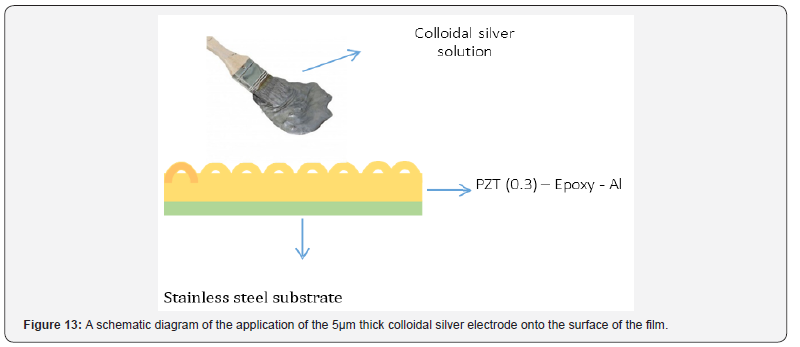
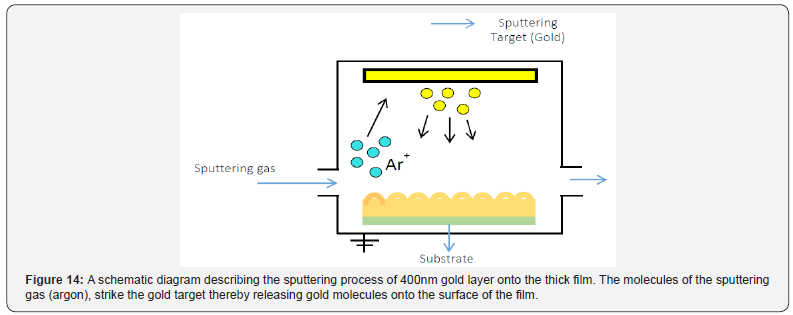
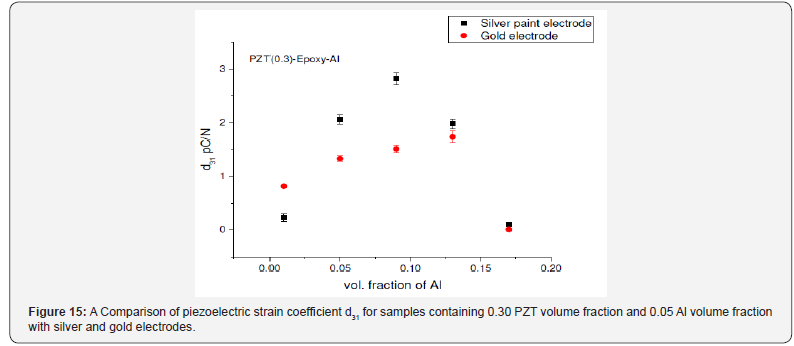
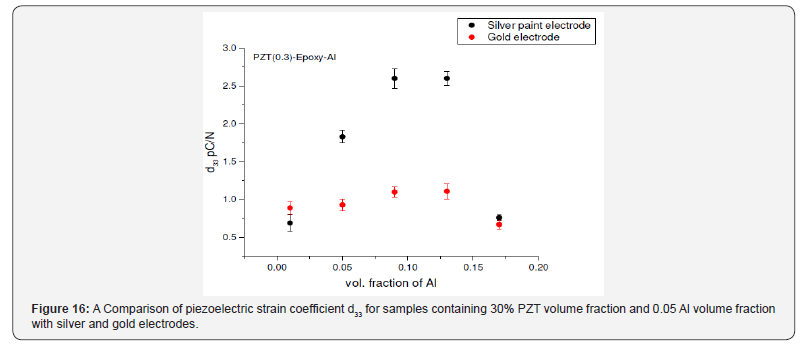
The electron transport properties at the interface of the
composite thick film surface and the device electrode are
influenced by the surface characteristics, such as the surface
morphology of the thick films, the contact resistance and the total
number of contact points connecting the thick film surface to the
surface of the device electrode [71-73]. To draw a comparison
between different top electrodes, the thick films were deposited
with gold (Au) and silver (Ag) electrodes. The electrical resistivity
and conductivity values are different for both materials. The
variation in the piezoelectric strain coefficients d33 and d31 of the
thick film are shown in Figure 15 & 16. The values are enhanced
by the addition of the metallic electrodes below the percolation
threshold. This improvement in the d33 and d31 values is due to the
decrease in the contact resistance and increase in the mobility
of electrons at the interface between the film surface and the
electrode due to the presence of the metallic layer [72]. We can
see a maximum d31 and d33 values for the samples with silver
electrode are 2pC/N and 2.5pC/N, respectively occur at ~13% Al.
These values are higher than that of gold, d31 and d33 are ~1.8pC/N
and ~1.2pC/N, respectively because of the decreased electrical
resistivity of silver (Ag ~0.00955 10-8 Ωm and Au ~0.0502 10-8
Ωm) [74].
The capacitance values are enhanced by the addition of the top
electrode. The top electrodes were applied to samples containing
a PZT volume fraction equal to 0.3 and aluminum volume fraction
equal to 0.05. The capacitance for of the samples with the gold
electrodes were ~43pF, ~42.8pF for the silver electrode and
~3.5pF when no electrode was applied. The enhancement of
the capacitance could be due to several factors such as electron
tunneling due to an increase in the intensity of local electric field
[63]. Also, the conductive layer reduces the losses due to metal
insulator transition and other interface defects as compared to
the compo- site without a conductive layer [72].
Effect of aging of samples
The composite properties were also recorded as a function
of time: 1, 5 and 1027 days of poling, to study the effect of aging
on the electromechanical properties of the composite. The
values measured after five days were slightly lower than the
values recorded after one day as indicated in Figures 17 & 18
through 21. This happened because the samples reached remnant
polarization gradually over time, and thus attained lower d33 and
d31 values as some of the dipoles that were forced to return to their
original position. The samples were measured again, 1027 days
after poling, the d31 and d33 values reduced only slightly (0.105-
0.235 less compared d33 of 5 days after poling), however they did
observe a similar trend in values varying with aluminum volume
fraction, as shown in Figure 20 & 21.
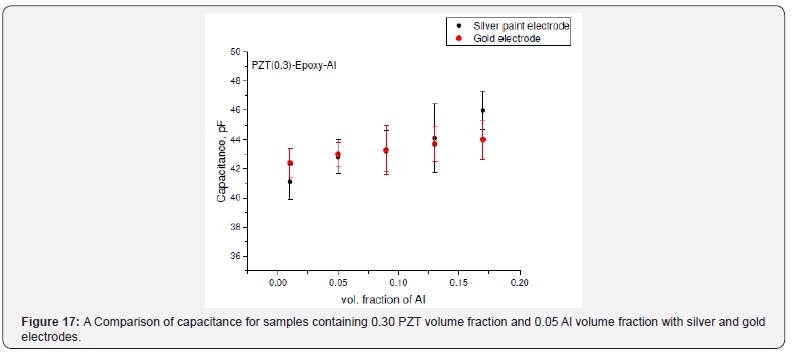
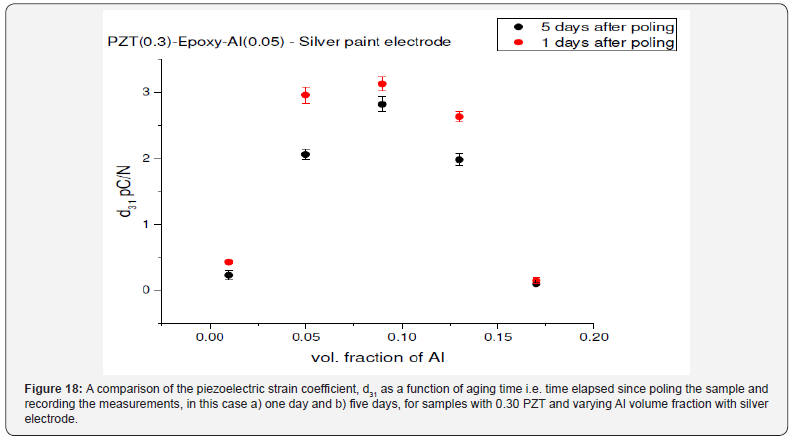
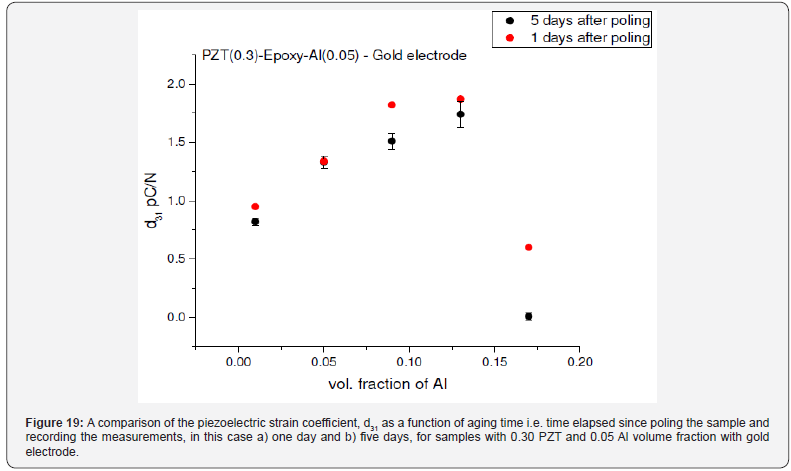
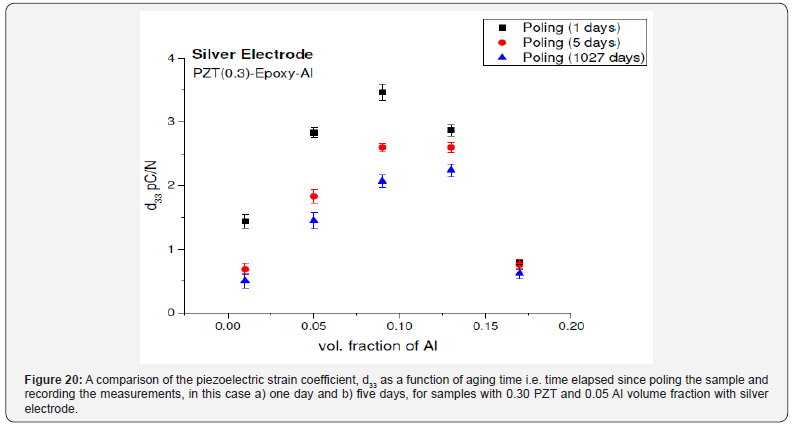
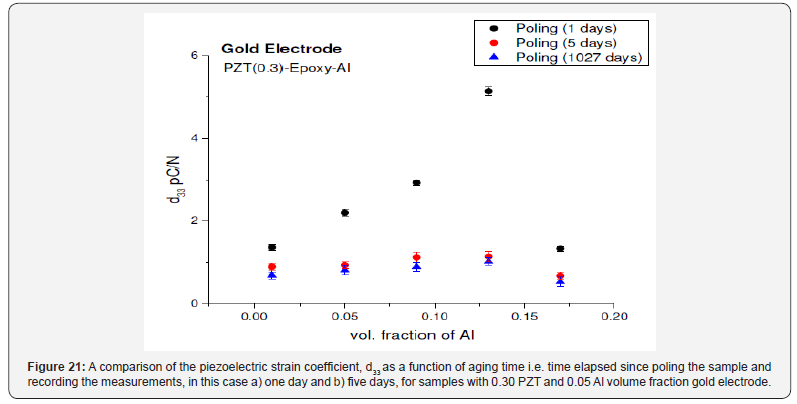
Conclusion
Three-phase piezoelectric PZT-epoxy-Al thick film composites
were fabricated and poled using parallel-plate contact poling
method. The volume fractions of PZT and Al were varied from
0.2 to 0.4 and 0.0 to 0.17 respectively. The piezoelectric strain
coefficient, d33 and d31 and the dielectric constant increased with
PZT and Al volume content. Furthermore, the piezo- electric strain
coefficients, longitudinal and axial, increased with Al volume
fraction culminating at 0.13, beyond which the values began to
drop. Two different top electrodes were applied to the samples,
gold and silver and their values were compared. Silver proved
to result in better overall properties due to reduced electrical
resistivity at the interface. An aging study was also carried out
to measure the piezoelectric strain coefficients between 1, 5 and
1027 days. The results showed that the values gradually dropped
over time, falling quickly between 1 and 5 days, and more gradually
between 5 and 1027 days.
Acknowledgement
This material is based upon work supported by the National
Science Foundation under Grant Numbers: EEC1659818, EEC1263250 and EEC1407266. In addition, we would like
to acknowledge support from the New Jersey Space grant
Consortium.
For more articles in Academic Journal of Polymer
Science please click on:
https://juniperpublishers.com/ajop/index.php
https://juniperpublishers.com/ajop/index.php

Comments
Post a Comment